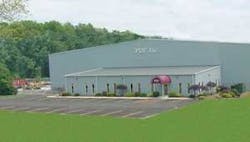Cutting through thick and thin
Fabrication shop surprises even itself when brisk business prompts it to buy two laser systems at once
David A. Belforte
Ken Maurer started Process Development & Fabrication (PDF) as a privately owned fabrication shop located in Brazil, Indiana, in 1994. With seven people the company began as a vertically oriented fabricator of lead oxide battery manufacturing systems, primarily as a supplier to General Motors Delco division. Today it operates as a specialty OEM machinery and equipment builder, still building and shipping lead oxide battery machines. The company’s machines are used in 15 countries around the world, all business gained from word-of-mouth advertising.
At PDF vertically oriented means the company, like an old-fashioned machine builder, does everything itself from design to machining, welding, wiring, metal cutting, and other production operations, including installation and startup of the systems. It has engineering personnel specializing in robotic, electrical system integration, electromechanical engineering, and fluid power. They take pride in their innovation capabilities, ready to take on any systems challenges.
In May of 2000 the company purchased its first multi-axis CO2 laser cutter and spent a year learning how to program and run three-dimensional shapes. Because this unit offered three-axes motion capability, formed parts could be cut prior for other fabrication operations. In addition this system afforded PDF the opportunity to cut tubing for its own use in the systems it built.
Like many startups, PDF found that offering some of its in-house fabrication services on a subcontract basis helped to pay the rent during machine building down cycles, so it began to use this laser to cut sheet metal for other companies, especially those that had need for prototype die blank trimming prior to designing and buying hard trim line dies. This laser proved so useful PDF decided, in 2001, to purchase another unit for flat sheet cutting, and by so doing found it could shift a lot of work from its punch presses onto the flat sheet cutter.
Business at PDF remained solid through the most recent recession in the U.S. manufacturing industry sector. Maurer says the company maintained and even increased market share, although profit margins were razor thin and profits were almost nonexistent, because of the diverse nature of the business and the fact that the company’s customers cover a broad geographic area.
Increased cutting capacity
As business prospects picked up for system work, and the market for contract laser cutting expanded, the company felt the need for more laser cutting capacity. And now the story takes an unusual twist. When Maurer and his son Jason visited their chosen supplier, Cincinnati Inc., they had difficulty in deciding which unit best suited their needs, which were to be able to cut both thick and thin materials in an efficient manner. And they wanted to be able to cut a range of metals from carbon steel, which was their major need, to stainless steel and even aluminum.
They looked at a conventional 4kW CL-7 laser cutter with dual shuttle tables and realized that loading fixturing for tubing cutting on the lower shuttle would give them extra flexibility. However they were also greatly interested in the high-speed cutting performance of a CL-7 that mounted a Rofin-Sinar 3.3kW slab CO2 laser. After relatively little discussion the Maurers decided to purchase both laser systems-the 4kW to handle both thick and thin metal sheet and the 3.3kW to cut thin sheet fast. Both these machines are used for the contract customer business, which represents some 30-40 percent of PDF’s annual revenues. One of the older machines, the 4kW flat sheet cutter, was sold.
Laser operators like the Cincinnati dual-pallet system because it allows them to fixture for a variety of cutting operations without tying up the work being done on the other table.
As stated earlier PDF does very little plain flat sheet cutting, most of its laser system throughput is for shaped and welded parts. The company cuts carbon steel in thicknesses up to ¼ inch, occasionally up to 5/8 inch, and quite a bit of stainless steel and some aluminum in the same thickness ranges. It runs O2 for cutting carbon steel and N2 for stainless and aluminum.
Maurer divides the shop load into two categories: Production, which is the subcontract business, requires three shifts/day six days/week on two cutters; and Fabrication, the manufacture of parts for the custom machines, for one shift/day, six days/week. Out of the 120 employees at the Brazil plant, 10 of them are assigned to the laser cutting systems.
When asked how he manages to compete with the ever-increasing number of laser cutting shops entering the market, Maurer states that from day one the company set a fair price, rather than a premium, for laser cutting. So, as new market capacity drove hourly laser cutting rates lower, PDF was able to hold its original pricing. This factor is also cited as one of the reasons the company serves customers from all over the U.S., many gained by word-of-mouth advertising. Currently the company has about 150 active job shop customers, who generate cutting demand for about 1000 different parts in quantities from 1 to 20,000 per year. The Fabrication side of the cutting demand, parts for PDF machines, calls for about 4000 different parts on 500 orders.
PDF is pleased with the Cincinnati machines. Because of its lengthy experience with other laser cutters, the startup of the new units went quickly and with few glitches, which PDF handled easily. Maurer speaks highly about Cincinnati, saying that when help is needed it is delivered expeditiously and efficiently. He considers this as a major selling point for Cincinnati, because PDF prides itself on responding quickly to its customer’s service requests.


